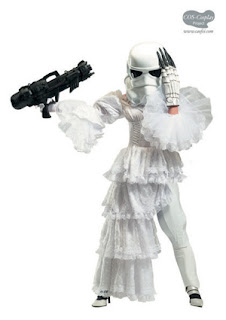I really like Cao Fei's artistic style: after my last post entitled CHINA POWER STATION I , I kept looking for her works, as something else displayed in the exhibition in Turin drew my attention: a few big pictures hanging on the wall and a video. The pictures were still imaeges taken from a documentary she did in 2004, entitled "Cosplayers" (an ultra-brief - and probably unnecessary - explaination: the word "cosplay" is the contraction of "costume" and "play", it originated in Japan and refers to a sort of performance art, in which participants dress up like some fa mous fictional characters, usually drawn from manga, anime, comics, animati on, video games, and so on). Unfortunately, I couldn't find Cao Fei's video online, but on her website I found a statement from which I would like to propose an exerpt, as it describes a peculiar phenomenon of popular culture that is becoming extremely trendy also in China:
"In recent years a group of COSPLAYERS, growing up in and around China's coastal cities, have been confronted by both the traditional values of the Chinese education system and subjected to the pull of invading foreign cultures in the new century. As a group of adolescents who refuse to grow-up, they choke themselves with passionate impulses and an undisguised infatuation with personal fancies, expressed through ways and manners only they can understand and be comfortable with. Their characters are often filled with violence, a thirst for power, as well as magical powers but, compared to the boredom, emptiness, rebelliousness, and violence that accompany the lives of many of today's adolescents, escaping inside this sub-cultural cocoon merely seeks to affirm the value of their own existence in society. They frequently and eagerly appear in all kinds of large and small commercial events or trendy places, gaining exposure in the news media, and setting themselves up as spoke-persons for young people today. In the process they attract the attention of many curious onlookers and a sizable peer group following. The satisfaction they gain from their contrived fantasy world counterbalances their despair and despondency in the real world. In fact, since they seek to hide their personality, the pleasure and sense of honor they gain derives from their virtual characters, not their natural identity. They are prepared to shoulder the burden of a split personality in the everyday world, for such a duality of reality and fantasy soothes and comforts their cravings in the same way as fairy tales have become an indispensable part of their lives." ( http://www.caofei.com/works/photography/ , choose "Coldplayers" on the right and this statement can be found after the first still )
Other photographic works about cosplayers are displayed on her website: Un-Cosplayers and Cos-Cosplayers. From this last series, I chose the ones I like best and share them here. I guess I like them because I appreciate the contrast of the romantic gothic outfit and the "bad" elements (namely the helmets) of Darth Vader and Stormtroopers from George Lucas' Star Wars.
I like the artistic style of Cao Fei: After I posted CHINA POWER STATION , I kept looking at his works, as something ' more exposed to the Turin exhibition had me curious: some pictures hanging on the wall and a video. The photographs were taken by a still image documentary of 2004, entitled "cosplayers" (a very fast - and probably not necessary - explanation: the word "cosplay" is short for "costume" and "play," originated in Japan and indicates a kind of performance art, in which participants dress as some famous people, usually from manga, anime, comics, animation, video games, and so on). Unfortunately, I found the video of Cao Fei, but I found a site in his statement, I want to propose a statement described as a peculiar phenomenon of popular culture, which is becoming a trend in China:
"In recent years a group of cosplayers, growing up in and around China's coastal cities, Have Been Confronted by Both the traditional values \u200b\u200bof the Chinese education system and subjected to the pull of invading foreign cultures in the new century. As a group of Adolescents who refuse to grow up, they're choke themselves with passionate impulses and an undisguised infatuation with personal fancies, expressed through ways and manners only they can understand and be comfortable with. Their characters are often filled with violence, a thirst for power, as well as magical powers but, compared to the boredom, emptiness, rebelliousness, and violence that accompany the lives of many of today's adolescents, escaping inside this sub-cultural cocoon merely seeks to affirm the value of their own existence in society. They frequently and eagerly appear in all kinds of large and small commercial events or trendy places, gaining exposure in the news media, and setting themselves up as spoke-persons for young people today. In the process they attract the attention of many curious onlookers and a sizable peer group following. The satisfaction they gain from their contrived fantasy world counterbalances their despair and despondency in the real world. In fact, since they seek to hide their personality, the pleasure and sense of honor they gain derives from their virtual characters, not their natural identity. They are prepared to shoulder the burden of a split personality in the everyday world, for such a duality of reality and fantasy soothes and comforts their cravings in the same way as fairy tales have become an indispensable part of their lives." ( http://www.caofei.com/works/photography/ , scegliere "Coldplayers" alla destra e questa dichiarazione comparirà sotto alla prima immagine still ).
On its website, you can find other photographs on cosplayers: A So-and-cosplayers cosplayers. Of this series, I chose the pictures that impressed me and set them down again here. I think I like because I like the contrast clothing Romantic and Gothic elements "bad" (helmets) to Darth Vader and Stormtroopers of Star Wars by George Lucas.




